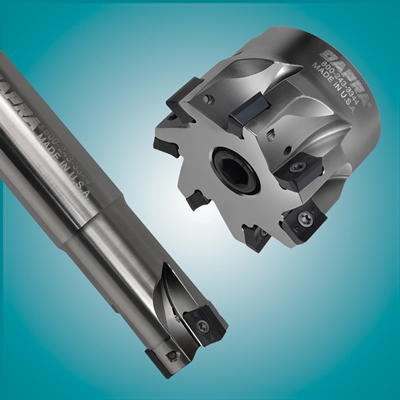
Dapra Corp. has introduced 12mm Cutter Bodies and Inserts to its line of 90 Square Shoulder precision mills. Machined from double-hardened tool steel to minimize runout and maximize strength, these cutters are designed with a fine pitch for faster feed rates and a smoother cutting action that generates less noise and pressure, according to the company.
This particular precision cutter and insert combination provides longer tool life and improved productivity, especially on lighter-duty machines. End Mills are available in cutting diameters from 0.625" to 1.500". Shell mills, with varying pitch options, cut from 1.5" to 4". Helical roughing end mills are available in 1.0" and 1.25" diameters. Utility cutters that maximize the economy of usage (available cutting edges) are available in .75", 2" and 3" diameters. The maximum depth of cut for 12mm inserts is 0.430".
The new 12mm inserts feature a stronger geometry for heavier cuts using smaller-diameter cutters. Inserts are available with an APET cutting edge for high-performance milling of most tougher/harder steels and cast irons, or an XPET cutting edge for softer steels, stainless steels and high-temperature alloys. Also available are XPET-ALU inserts, ground to a sharp edge for non-ferrous applications, including aluminum, plastics and wood.
Contact Details
Related Glossary Terms
- alloys
alloys
Substances having metallic properties and being composed of two or more chemical elements of which at least one is a metal.
- cast irons
cast irons
Cast ferrous alloys containing carbon in excess of solubility in austenite that exists in the alloy at the eutectic temperature. Cast irons include gray cast iron, white cast iron, malleable cast iron and ductile, or nodular, cast iron. The word “cast” is often left out.
- depth of cut
depth of cut
Distance between the bottom of the cut and the uncut surface of the workpiece, measured in a direction at right angles to the machined surface of the workpiece.
- feed
feed
Rate of change of position of the tool as a whole, relative to the workpiece while cutting.
- gang cutting ( milling)
gang cutting ( milling)
Machining with several cutters mounted on a single arbor, generally for simultaneous cutting.
- milling
milling
Machining operation in which metal or other material is removed by applying power to a rotating cutter. In vertical milling, the cutting tool is mounted vertically on the spindle. In horizontal milling, the cutting tool is mounted horizontally, either directly on the spindle or on an arbor. Horizontal milling is further broken down into conventional milling, where the cutter rotates opposite the direction of feed, or “up” into the workpiece; and climb milling, where the cutter rotates in the direction of feed, or “down” into the workpiece. Milling operations include plane or surface milling, endmilling, facemilling, angle milling, form milling and profiling.
- pitch
pitch
1. On a saw blade, the number of teeth per inch. 2. In threading, the number of threads per inch.
- stainless steels
stainless steels
Stainless steels possess high strength, heat resistance, excellent workability and erosion resistance. Four general classes have been developed to cover a range of mechanical and physical properties for particular applications. The four classes are: the austenitic types of the chromium-nickel-manganese 200 series and the chromium-nickel 300 series; the martensitic types of the chromium, hardenable 400 series; the chromium, nonhardenable 400-series ferritic types; and the precipitation-hardening type of chromium-nickel alloys with additional elements that are hardenable by solution treating and aging.






